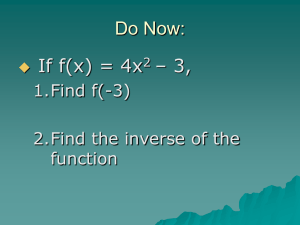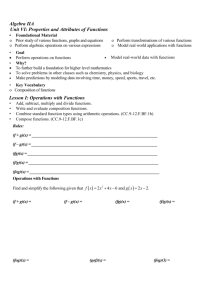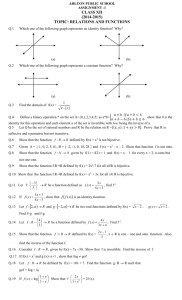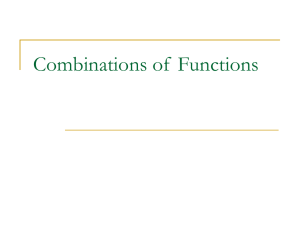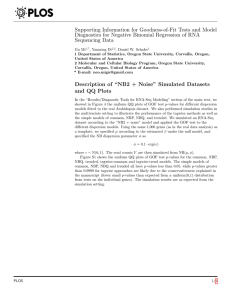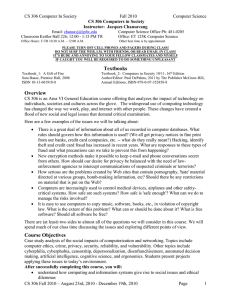Composition of Function
advertisement
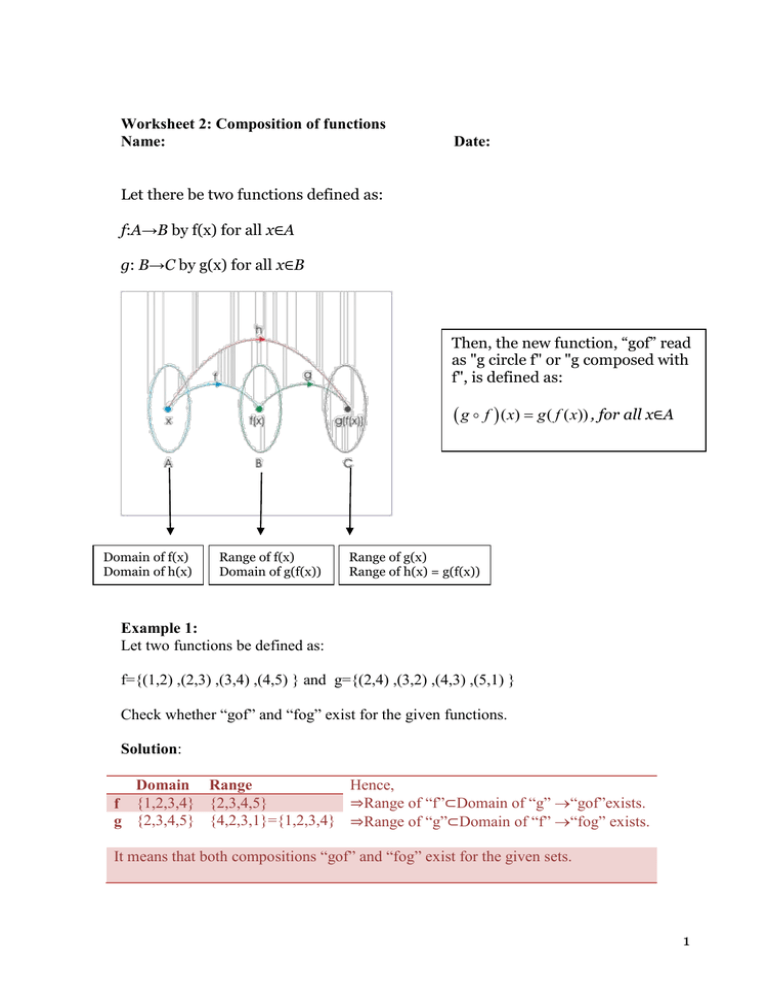
Worksheet 2: Composition of functions
Name:
Date:
Let there be two functions defined as:
f:A→B by f(x) for all x∈A
g: B→C by g(x) for all x∈B
Then, the new function, “gof” read
as "g circle f" or "g composed with
f", is defined as:
g
Domain of f(x)
Domain of h(x)
Range of f(x)
Domain of g(f(x))
f ( x) g ( f ( x)) , for all x∈A
Range of g(x)
Range of h(x) = g(f(x))
Example 1:
Let two functions be defined as:
f={(1,2) ,(2,3) ,(3,4) ,(4,5) } and g={(2,4) ,(3,2) ,(4,3) ,(5,1) }
Check whether “gof” and “fog” exist for the given functions.
Solution:
Hence,
Domain Range
⇒Range of “f”⊂Domain of “g” “gof”exists.
f {1,2,3,4} {2,3,4,5}
g {2,3,4,5} {4,2,3,1}={1,2,3,4} ⇒Range of “g”⊂Domain of “f” “fog” exists.
It means that both compositions “gof” and “fog” exist for the given sets.
1
Example 2:
Given f ( x) 2 x 1 and g ( x) x 2 3 , find:
a. ( f o g)(x).
b. ( g o f)(x).
c. ( f o f)(x).
d. ( g o g)(x).
Solution:
a. f g x f g x f x 2 3 2 x 2 3 1 2 x 2 7 .
b.
c.
d.
g
f x g f x g 2 x 1 2 x 1 3
f
g
f x f f x f 2x 1 2 2 x 1 1 4x 3
2
4 x 2 4 x 1 3 4 x 2 4 x 2
g x g g x g x 2 3 x 2 3 3
2
x4 6x2 9 3 x4 6 x2 6
Note that:
f g x 2x2 7 g f x 4x2 4x 2
That is, ( f o g)(x) is not the same as (g o f )(x). The open dot "o" is not the same
as a multiplication dot "•", nor does it mean the same thing.
f(x) • g(x) = g(x) • f(x)
[always true for multiplication]
...you cannot say that:
( f o g)(x) = (g o f )(x)
[generally false for composition]
Domain and range of the composition of functions
Consider the function:
f ( x)
1
, when x 1 Domain of f is 1 , i.e. all real numbers but 1.
1 x
2
Let us now see the expression of composition of function with itself,
f
1
1
f x f f x f
1 x 1 1
1 x
1
1
1 x x 1
valid for real values of x≠0.
1 x
1
x
x
x
1 x 1 x 1 x
Since f is undefined for x = 1, and f
composition f
f is undefined for x = 0, thus the domai n of the
f x is : 0,1 ; i.e. all real numbers except 0 and 1.
Sometimes you have to be careful with the domain and range of the composite function.
General rule to determine the domain:
f ( x)
Polynomial
f ( x)
x0
Domain
1
x
f ( x) x
f ( x) log( x)
f ( x) a x
x0
x0
, for a 0 ,
0 ,for a 0
Example:
Given f ( x) x and g ( x) x 3 , find the domains of ( f o g)(x) and (g o f )(x).
Solution:
f ( x) x x 0
So:
f
g x f g x x 3 x 3 0 x 3
Hence, the domain of ( f o g)(x) is "all x > 3".
Now do the other composition:
g
f x g g x ...
Hence, the domain of (gof)(x) is …
3
Going backward: given composed function, find original functions
Usually composition is used to combine two functions. But sometimes you are asked to
go backwards. That is, they will give you a function, and they'll ask you to come up with
the two original functions that they composed.
Example 1:
Given h x x 5 3 x 5 7 , determine two functions f (x) and g(x) which, when
composed, generate h(x).
2
Solution:
This is asking you to notice patterns and to figure out what is "inside" something else.
In this case, this looks similar to the quadratic x 2 3 x 7 , except that, instead of squaring
x, they're squaring x + 5.
So let's make g(x) = x + 5, and then plug this function into f x x2 3x 7 :
f
g x f g x f x 5 x 5 3 x 5 7
2
Then h(x) may be stated as the composition of f x x2 3x 7 and g(x) = x + 5.
Example 2:
Given h x 3x 4 , determine two functions f (x) and g(x) which, when composed,
generate h(x).
Solution:
Since the square root is "on" (or "around") the "3x + 4", then the 3x + 4 is put inside the
square root, that is:
h ( x ) f ( g ( x ))
x
3x 4
g x
f x
3x 4
Thus, g(x) = 3x + 4, f x x , and h(x) = ( f o g)(x).
4
Exercise
For the given functions:
a. f(x) = x + 1 , g(x) = 3x
b. f ( x) x 2 1, g ( x) 2 x
c. f ( x) x 1, g ( x) x 2 5
d. f(x) = 2x + 1 , g(x) = x2
Find:
1. Domain and range of each f(x) and g(x)
f x
g x
a. Domain =
Range =
b. Domain =
Range =
b. Domain =
Range =
Domain =
Range =
Domain =
Range =
Domain =
Range =
c. Domain =
Range =
Domain =
Range =
2. Determine f g x and its domain
a.
f
g x
Domain =
b.
f
g x
Domain =
c.
f
g x
5
Domain =
d.
f
g x
Domain =
3. Determine g f x and its domain
a.
g
f x
Domain =
b.
g
f x
Domain =
c.
g
f x
Domain =
d.
g
f x
Domain =
4. Determine f
a.
f
f x and its domain
f x
Domain =
b.
f
f x
6
Domain =
c.
f
f x
Domain =
d.
f
f x
Domain =
5. Determine g g x and its domain
a.
g
g x
Domain =
b.
g
g x
Domain =
c.
g
g x
Domain =
d.
g
g x
Domain =
6. A function is defined for real values by : f ( x)
1
for all real values except x
1 x
=1 . Determine f f f x and draw the graph of resulting composition!
7
7. Given f(2) = 3, g(3) = 2, f(3) = 4 and g(2) = 5, evaluate (f o g)(3)!
8. Functions f and g are as sets of ordered pairs
f = {(-2,1),(0,3),(4,5)} and g = {(1,1),(3,3),(7,9)}
Find the composite function defined by g o f and describe its domain and range.
9. Write function F given below as the composition of two functions f and g, where
1
1
g ( x ) and F ( x) x
1 x
x
8
10. Evaluate f(g(h(1))), if possible, given that h( x) x , g ( x) x 1, and
f ( x)
1
.
x2
11. For the composite function f g ( x) and f ( x) , find g x !
a.
f
g ( x) x , f ( x) x 2 2
b.
f
g ( x) 2 x 6 x 2 1 , f ( x ) 2 x 3 x 1
c.
f
g ( x) x 1 4 , f x x 2 4
d.
f
g ( x) x, f x x 2 5
2
9
12. For the composite function f g ( x) and g ( x ) , find f x !
e.
f
g ( x) sin x 2 1 , g ( x) x 2 1
f.
f
g ( x) x , g ( x) 1 x 2
g.
f
g ( x) 4 x, g ( x) x
1
x , g ( x) 1 1
h. f g ( x)
x
1
1 1
x
1
10
